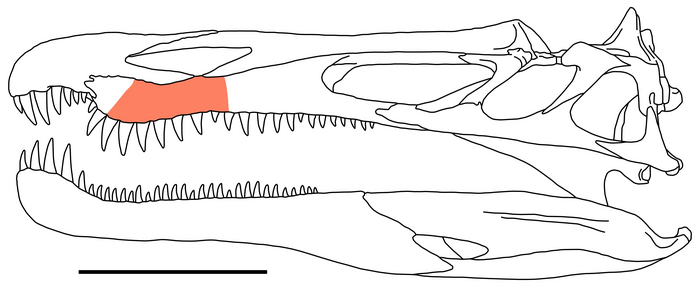This has been confirmed in the article ‘New contributions to the skull anatomy of spinosaurid theropods: Baryonychinae maxilla from the Early Cretaceous of Igea (La Rioja, Spain)’ published in the journal Historical Biology by Iker Isasmendi (lead author) and Xavier Pereda of the UPV/EHU-University of the Basque Country, Pablo Navarro of the UR-University of La Rioja, Angélica Torices, director of the Chair of Palaeontology at the UR, plus other experts of the Complutense University of Madrid and the Palaeontological Visitors’ Centre of La Rioja.

Credit: Erik Isasmendi. UPV/EHU.
This has been confirmed in the article ‘New contributions to the skull anatomy of spinosaurid theropods: Baryonychinae maxilla from the Early Cretaceous of Igea (La Rioja, Spain)’ published in the journal Historical Biology by Iker Isasmendi (lead author) and Xavier Pereda of the UPV/EHU-University of the Basque Country, Pablo Navarro of the UR-University of La Rioja, Angélica Torices, director of the Chair of Palaeontology at the UR, plus other experts of the Complutense University of Madrid and the Palaeontological Visitors’ Centre of La Rioja.
Scientists have reassessed fossil jaw remains published by Viera and Torres in 1995 and found in 1983 in a Lower Cretaceous site at Igea (La Rioja, Spain). The remains constitute a fragment of a left maxilla belonging to a carnivorous dinosaur and in which 8 alveoli have been preserved. Using microCT techniques, they discovered the remains of several teeth developing simultaneously in one of these dental sockets.
“We recognised up to three generations of teeth in the same alveolus: the functional tooth of the animal, another tooth being formed and which would replace the first, and the germ of the one that would end up replacing the second,” explained Pablo Navarro of the UR.
“This suggests very rapid tooth replacement and is probably one of the reasons why so many spinosaurid teeth can be found on the Iberian Peninsula during the Lower Cretaceous,” added the co-author of the paper.
To date, some species of spinosaurids –medium/large carnivorous dinosaurs with elongated skulls and crocodile-like conical teeth– were known to replace their teeth faster than other theropods, in just two months (replacement rate estimated to be 60-68 days); the research confirms that this is a trait shared by the whole group and provides evidence of how this change occurred, i.e. it was made possible by the development of several replacement teeth at the same time.
“Throughout their lives these animals grew new teeth that gradually replaced the original ones and caused them to fall out. This means that the same animal could generate multiple teeth,” said Pablo Navarro.
“These teeth, more or less conical in shape and a centimetre in size, were transported by rivers, accumulated in lake areas and, over time, became fossilised,” said the researcher. They are one of the most common vertebrate remains in Iberian sites of the Lower Cretaceous (between 145 and 113 million years ago)”.
Although it is not known precisely why their teeth were replaced so often, it is believed that this allowed them to possess a greater number of functional teeth at all times. This was a decisive advantage when withstanding the considerable effort required to hold their prey by trapping them between their jaws.
In addition to these findings, the research has enabled the classification of the jaw studied to be clarified: the experts do not attribute it, as previously thought, to the genus Baryonix, but to another type of spinosaurid very close to it, an indeterminate baryonychid.
The palaeontological studies carried out to date at Igea are significant because of the presence of numerous spinosaur skeletal remains, including partial skeletons belonging to several individuals. “The current research will allow our knowledge about the diversity of this unique group of carnivorous dinosaurs to be improved. It is likely that at least two different species are represented at the Igea sites,” said Erik Isasmendi and Xabier Pereda-Suberbiola, palaeontologists in the UPV/EHU’s Department of Geology; consequently, this Riojan locality is one of the world’s leading locations in the study of spinosaurs.
Journal
Historical Biology
DOI
10.1080/08912963.2022.2069019
Article Title
New contributions to the skull anatomy of spinosaurid theropods: Baryonychinae maxilla from the Early Cretaceous of Igea (La Rioja, Spain)
Article Publication Date
17-May-2022




